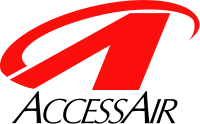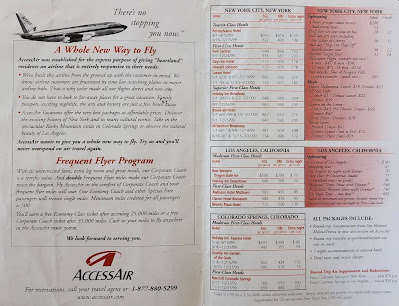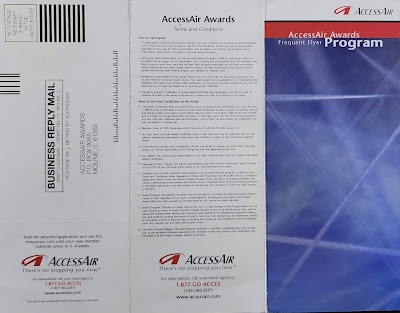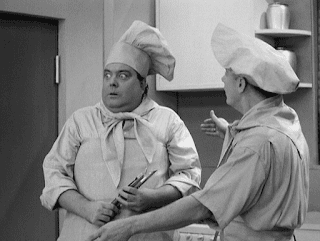Long-time readers now know that my day job is flying around America as an airline pilot. I grew up always wanting to fly like Superman, but airplanes became the next best thing when I realized that wasn't physically possible. I always sort of thought I wanted to be an airline pilot, but then, in the summer of 1999, I fell in love with the airline business.
Just a few short months later, as summer ended and 10th grade started. Around then, my parents decided we would go visit my grandmother, who had just remarried and moved to Iowa. Her new husband owned a farm in a tiny town southeast of Des Moines. At the time, getting from New York to Iowa without several connections and costly airfare was impossible.
AccessAir to the rescue.
Who?
Yeah, that's the question most people asked... and still ask. Honestly, I had never heard of them either, but one day my Mom said she had bought tickets on an airline that flew from La Guardia to Quad Cities/Moline.
Where?
Tenth-grade me had no idea where that was. I'll save you the Google mapping: it's where Illinois and Iowa meet in Illinois' northwest corner.
Then she said the plane had to stop in Peoria first. Peoria? Oh, this was going to be some experience, alright.
My best friend in high school was also a plane nut. We joked and made fun of this airline for weeks before our trip. The internet was still somewhat new, and the information we could find was minimal. Either way, we entertained ourselves during school with made-up stories about cornfield landings and duct tape and bubble gum repair jobs by drunken mechanics.
Then the day came. We drove to La Guardia and checked in. I waited for the plane, an older model Boeing 737 (the -200 variant), to arrive. When the plane arrived, its polished metal shined brightly in the sun. Sleek red and black cheatlines ran down the middle of the aircraft. Damn, it was sexy.
We got on, and immediately the smells of an airliner hit me: brewing coffee, sandwiches, other meal service items, and a hint of air freshener.
Planes don't smell like that today. Today, coffee isn't normally brewed until you're airborne, so the aroma of a fresh cup of joe isn't there during boarding. Forget sandwiches and air freshener as well. These days there isn't food beyond prepackaged "cookies," and the plane gets a minimal cleaning between flights (at best.) We've fallen so far in just 20 years, but I digress.
 |
| Another photo from my personal collection. Taken from the rental car parking lot in Moline, Illinois, after our flight. This plane would eventually head for Colorado Springs and, finally, Los Angeles. |
We flew across the midwest and arrived in Peoria. We were on the ground for maybe 20 minutes as the plane added gas and a handful of passengers before quickly becoming airborne again. Within the hour, we were wheels down in Moline.
I was enamored with it all. The airline's logo strikes me as one of the best airline logos ever. The shade of red chosen by the company somehow strikes a chord deep within me. It's bright and bold but not gaudy. We received a full meal service, a cold-cut sandwich, and several side dishes like chips, carrots, and cookies. I can still picture the plastic cup with the airline's logo emblazoned on the side, sitting on my tray table as my Coke's carbonation bubbled away. I took photos and grabbed anything I could with the Access logo from the ticket counter.
I loved it. I knew then that I needed to be around it as a career. It wasn't a choice.
My trip earlier that summer on Business Express may have hooked me on the airline business, but AccessAir enforced in me that I only had one desire for a career. I HAD to be the guy that flew these airplanes around the country.
So, what about AccessAir? Whatever happened to it?
In 1996, Roger Ferguson, a former Naval aviator and the retired Senior Vice President of Engineering and Maintenance for Eastern Airlines came up with the idea for AccessAir. He began drumming up support for a new airline that would lower airfares for Iowa's residents and eventually the entire country.
After several delays, the airline secured financing through investments from mostly Midwest-based companies. Caterpillar Inc., along with FBL Financial, Principal Financial, MidAmerican Energy, and Pioneer Hi-Bred of Des Moines, would be the largest investors in the airline. In February and March of 1998, AccessAir acquired its first pair of aircraft, two used Boeing 737-200s, previously flown by Lufthansa of Germany.
The airline took flight on February 3, 1999, with service from Des Moines to La Guardia in New York, Peoria, Illinois, Quad City/Moline, Illinois, and Los Angeles, California. Colorado Springs, Colorado, was added shortly after.
Flying on AccessAir was an interesting way of crossing the country. One could buy a ticket in New York's LaGuardia Airport bound for Los Angeles but must make a minimum of 2 stops, and at other times 3, before arriving in L.A. The shortest way to travel coast to coast would be to stop in Moline and Colorado Springs first. The longest would require stops in Peoria, Moline, and Colorado Springs before arriving in Los Angeles 9 hours later.
This unconventional way of scheduling "through-flights" was not a new practice and one that is most associated with the early days of Southwest Airlines. On a through-flight, the plane arrives at the station and receives fuel and other services like catering while a handful of people depart the aircraft before boarding new passengers. In a matter of minutes, often under 20, the plane is back in the air bound for its next destination.
For plane nerds like me, it was an excellent way to experience another takeoff and landing. For your average passenger, though, who just wanted to get from one coast to the other quickly, it was rather inconvenient.
Even though it may have been inconvenient, it was worth putting up with for the budget-conscious traveler. It may have taken eight or nine hours to hopscotch across the country, but there were no plane changes, and the price was right. According to an old article on TheStreet.com, Access advertised round-trip fares between La Guardia and LAX as $336 with a Saturday-night stayover. Keep in mind, this is 1999 money were talking about. Without the Saturday stayover, the fare is $544. They also advertised anyone under 25 or over 62 years old, the same round trip would be $284 regardless of stayover.
The article also compared the same route; Northwest Airlines charged about $1,732.
 |
| Another from my personal collection, this interesting pamphlet explained the complicated pricing structure for fares from New York and Los Angeles based on the passengers' age and day of the week. |
Quite the difference in pricing from the competition, but unfortunately, it wouldn't entice enough people to fly on AccessAir.
AccessAir also provided select nonstop flights between Des Moines, Colorado Springs, Los Angeles, and Quad Cities/Moline.
The same route map from October 12, 1999, indicated the airline had plans to eventually fly to Boston, Washington, D.C., Miami, San Francisco, Portland, and Seattle.
Three more 737s would join the fleet in June and July of 1999 to expand the frequency of service between cities. The third (the airline's fifth plane) would arrive in November of 1999, just weeks before the airline filed for Chapter 11 Bankruptcy protection.
 |
| A screenshot of AccessAir's website from October 1999 (courtesy archive.org) |
Despite offering discounted ticket rates well below major carriers, such as the $99 "Family Saver Fare" advertised on their website, AccessAir struggled to fill its planes. The airline stopped flying 9 months after beginning service and was forced to file for Chapter 11 bankruptcy protection on November 29, 1999.
CEO and founder Roger Ferguson stepped down from his role with the company following the bankruptcy filing. His right-hand man, Rich Musal, filled the position at the dormant airline until February 2000.
In the nine months the airline was airborne, they recorded carrying only 14,000 passengers. This resulted in an estimated loss of $30 million. When the airline closed operations, approximately 4,000 passengers were left holding useless tickets. The airline promised refunds but never came through on the majority of them. Major creditors received between 8 and 15 cents on the dollar from the bankrupt airline.
During the spring of 2000, Des Moines business mogul John Ruan III injected necessary funds into the business and assumed control of the company, looking to restart operations. Ruan would own 85 percent of the airline while receiving the remainder in private loans.
The airline simplified its schedule to only one city. Chicago, Illinois, was the closest major market to Des Moines and became the only destination served by the "new" Access. The reduced schedule allowed the airline to trim down from five aircraft to only two.
The new operation managers were Donald Armington, a former Iowa Air National Guardsman, and Steve Wilson, a jet pilot with 22 years in the airline business. Compared to the 360 employees at the time of shutdown, the "new" airline employed only 100. Reservations and other smaller day-to-day operations were contracted out.
After nearly a year after it stopped flying, AccessAir again took to the sky in November 2000 with three daily flights from Des Moines to Chicago's Midway Airport. AccessAir had struck a deal with another now-defunct airline, American Trans Air (ATA), which had a large operation based at Chicago's Midway. AccessAir passengers could arrive from Des Moines and connect on any number of ATA flights to several destinations nationwide.
The airline publicly said it hoped to eventually add service to Las Vegas, Phoenix, Los Angeles, and Cedar Rapids, Iowa.
Unfortunately, the airline blamed low passenger counts and financial setbacks on "the first version" of AccessAir, which caused the airline to stop flying again 3 months later, in February 2001. The airline struggled to raise more capital through public or private loans. AccessAir said it had hoped to lure new customers to the airline using deeply discounted airfares but placed more blame on bad winter weather and a slowing economy as reasons passenger counts stayed low.
Passenger loads were reported to average only 28 passengers per flight on AccessAir's 117-seat aircraft. The aircraft was simply too big for what the airline was trying to accomplish. In a statement to the press, the airline revealed it had failed (despite previously announcing to the contrary) to make an arrangement with Ozark Air Lines of Columbia, Missouri, to use their 35-passenger regional jets (the Dornier 328Jet) on the Chicago route.
At the time, Des Moines City Councilwoman Christine Hensley stated, "If AccessAir were to start from day one the way it started with John Ruan III and the Ruans running it, I think it would have made all the difference in the world. There was just so much baggage from the first time out of the chute that I think it would be difficult for them to overcome that."
What baggage was she referring to? It's difficult to say 23 years later when discussing a privately held company that was not required to disclose all of its financial arrangements. Especially during a time when not everything was made available online for anyone to peruse.
Perhaps several lawsuits by AccessAir's original founder, Roger Ferguson, that accused three major airlines, Delta Air Lines, Northwest Airlines, and Trans World (TWA), of predatory pricing proved costly for the startup airline. The airline had only been flying one month when Ferguson involved the United States Department of Transportation and the three aforementioned airlines in expensive court battles.
As an industry insider of nearly two decades, I'd also guess the expensive real estate at LaGuardia and Los Angeles played a significant factor. Obviously, the saying "go where the people are" is essential, but with the haphazard "through-flight" schedule, the flying public didn't turn up. I would also guess that advertising and marketing weren't AccessAir's strong suit. When things like Google didn't exist, it's a wonder my Mom ever discovered the airline flew from New York to Iowa.
Crew training costs in the airline industry are very high. Not to mention, Access would have been mandated to create policies and procedures or purchase them from another airline at great expense.
It could be that Helane Becker, an airline analyst with Buckingham Research Group, nailed the answer way back in 1999. She said that "not every town can support an airline..." and questioned if there was even a "big rush to get in and out of Des Moines."
She also mentioned that, while the New York to Los Angeles route could be profitable, it "will appeal to some segments of the market, but after everybody takes their one trip, what is Access going to do?"
In the end, AccessAir just couldn't make a go of it. Perhaps Des Moines, Iowa, just isn't meant to be the hub of an airline. Maybe the planes were old and expensive, or the schedule was inconvenient for the flying public. Perhaps the economy slid backward, and jet fuel prices rose at the wrong time. Perhaps... any number of things.
I must close this article by simply saying: thank you. Thank you to AccessAir, and thank you to anyone who worked there. Thank you to my parents for deciding to take me out of school and head to Iowa for a week on an airline nobody had ever heard of. Thank you, AccessAir, for solidifying that I wanted to spend my life flying people around this great country for a living.
And thank you for reading.
If you ever worked for AccessAir, I'd love to talk to you about your time and memories of the airline.
For those interested, I scanned in some more AccessAir keepsakes that you may find interesting or informative. You can find those below. Enjoy!
 |
| A leftover luggage tag |
 |
| I was member #1465379 |
I've saved all of these documents for years, along with other AccessAir paraphernalia I've purchased off eBay and other sites. I have an ornate commemorative dinner plate honoring AccessAir's first flight in February 1999. I also have checklists and weight and balance cards that former Access pilots put up for sale.
Like I said above, if you ever worked for AccessAir, I'd love to talk to you about your time and memories of the airline.
Please leave a comment below or follow me on Twitter or shoot me an email. The links for those can be found to the right.



























.png)





Comments